
In 2025 and beyond, the data center liquid cooling market size is poised for significant growth, reshaping the cooling landscape of hyperscale and enterprise data centers. As data volumes surge due to cloud computing, AI workloads, and edge deployments, traditional air-cooling systems are struggling to keep up. Enter liquid cooling—a next-gen solution gaining traction among CTOs, infrastructure heads, and facility engineers globally.
Market Size Overview: A Surge in Demand
The global data center liquid cooling market size was valued at USD 21.14 billion in 2030, and it is projected to grow at a CAGR of over 33.2% between 2025 and 2030. By 2030, fueled by escalating energy costs, density of server racks, and the drive for energy-efficient and sustainable operations.
This growth is also spurred by tech giants like Google, Microsoft, and Meta aggressively investing in high-density AI data centers, where air cooling simply cannot meet the thermal requirements.
What’s Driving the Market Growth?
- AI & HPC Workloads
The rise of artificial intelligence (AI), deep learning, and high-performance computing (HPC) applications demand massive processing power, generating heat loads that exceed air cooling thresholds. - Edge Computing Expansion
With 5G and IoT adoption, edge data centers are becoming mainstream. These compact centers often lack space for elaborate air-cooling systems, making liquid cooling ideal. - Sustainability Mandates
Governments and corporations are pushing toward net-zero carbon goals. Liquid cooling can reduce power usage effectiveness (PUE) and water usage, aligning with green data center goals. - Space and Energy Efficiency
Liquid cooling systems allow for greater rack density, reducing the physical footprint and optimizing cooling efficiency, which directly translates to lower operational costs.
Key Technology Trends Reshaping the Market
- Direct-to-Chip (D2C) Cooling: Coolant circulates directly to the heat source, offering precise thermal management.
- Immersion Cooling: Servers are submerged in thermally conductive dielectric fluid, offering superior heat dissipation.
- Rear Door Heat Exchangers: These allow retrofitting of existing setups with minimal disruption.
- Modular Cooling Systems: Plug-and-play liquid cooling solutions that reduce deployment complexity in edge and micro-data centers.
Regional Insights: Where the Growth Is Concentrated
- North America leads the market, driven by early technology adoption and hyperscale investments.
- Asia-Pacific is witnessing exponential growth, especially in India, China, and Singapore, where government-backed digitalization and smart city projects are expanding rapidly.
- Europe is catching up fast, with sustainability regulations pushing enterprises to adopt liquid cooling for energy-efficient operations.
Download PDF Brochure – Get in-depth insights, market segmentation, and technology trends
Key Players in the Liquid Cooling Space
Some of the major players influencing the data center liquid cooling market size include:
- Vertiv Holdings
- Schneider Electric
- LiquidStack
- Submer
- Iceotope Technologies
- Asetek
- Midas Green Technologies
These innovators are offering scalable and energy-optimized solutions tailored for the evolving data center architecture.
Forecast Outlook: What CTOs Need to Know
CTOs must now factor in thermal design power (TDP) thresholds, AI-driven workloads, and sustainability mandates in their IT roadmap. Liquid cooling is no longer experimental—it is a strategic infrastructure choice.
By 2027, more than 40% of new data center builds are expected to integrate liquid cooling systems, according to recent industry forecasts. This shift will dramatically influence procurement strategies, energy models, and facility designs.
Request sample report – Dive into market size, trends, and future
Conclusion:
The data center liquid cooling market size is set to witness a paradigm shift in the coming years. With its ability to handle intense compute loads, reduce energy consumption, and offer environmental benefits, liquid cooling is becoming a must-have for forward-thinking organizations. It is time to evaluate and invest in liquid cooling infrastructure now—not just to stay competitive, but to future-proof their data center operations for the AI era.
